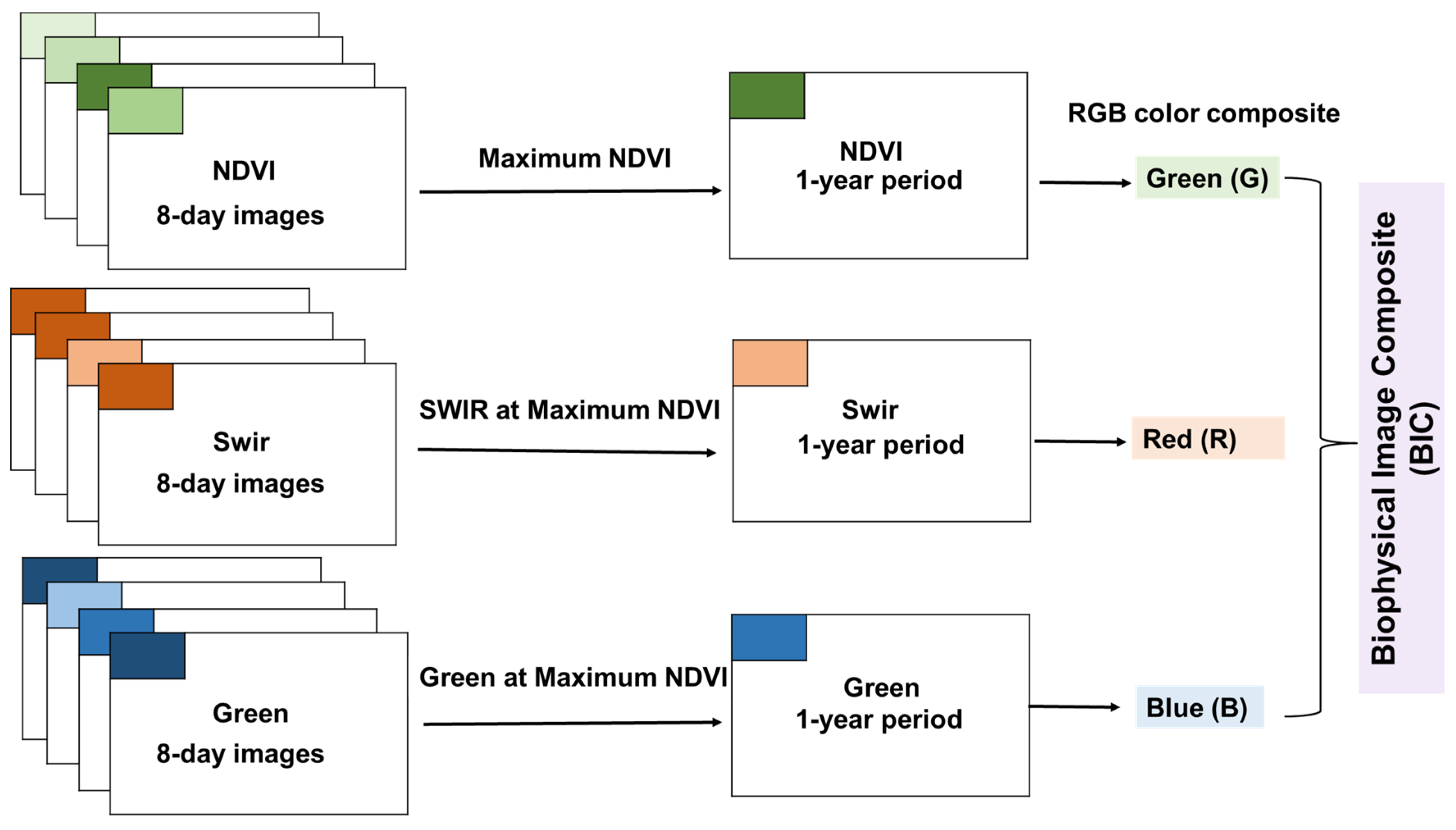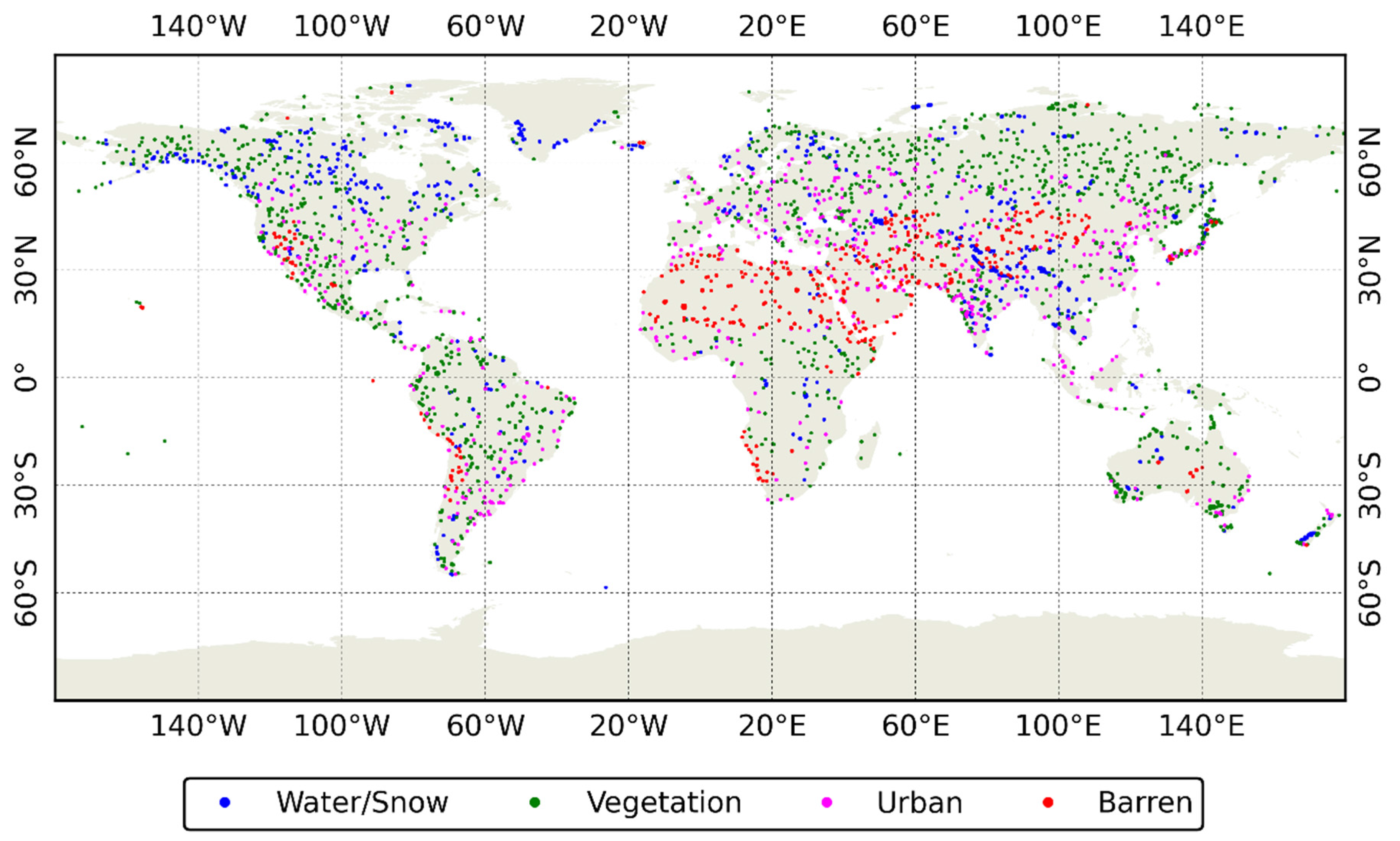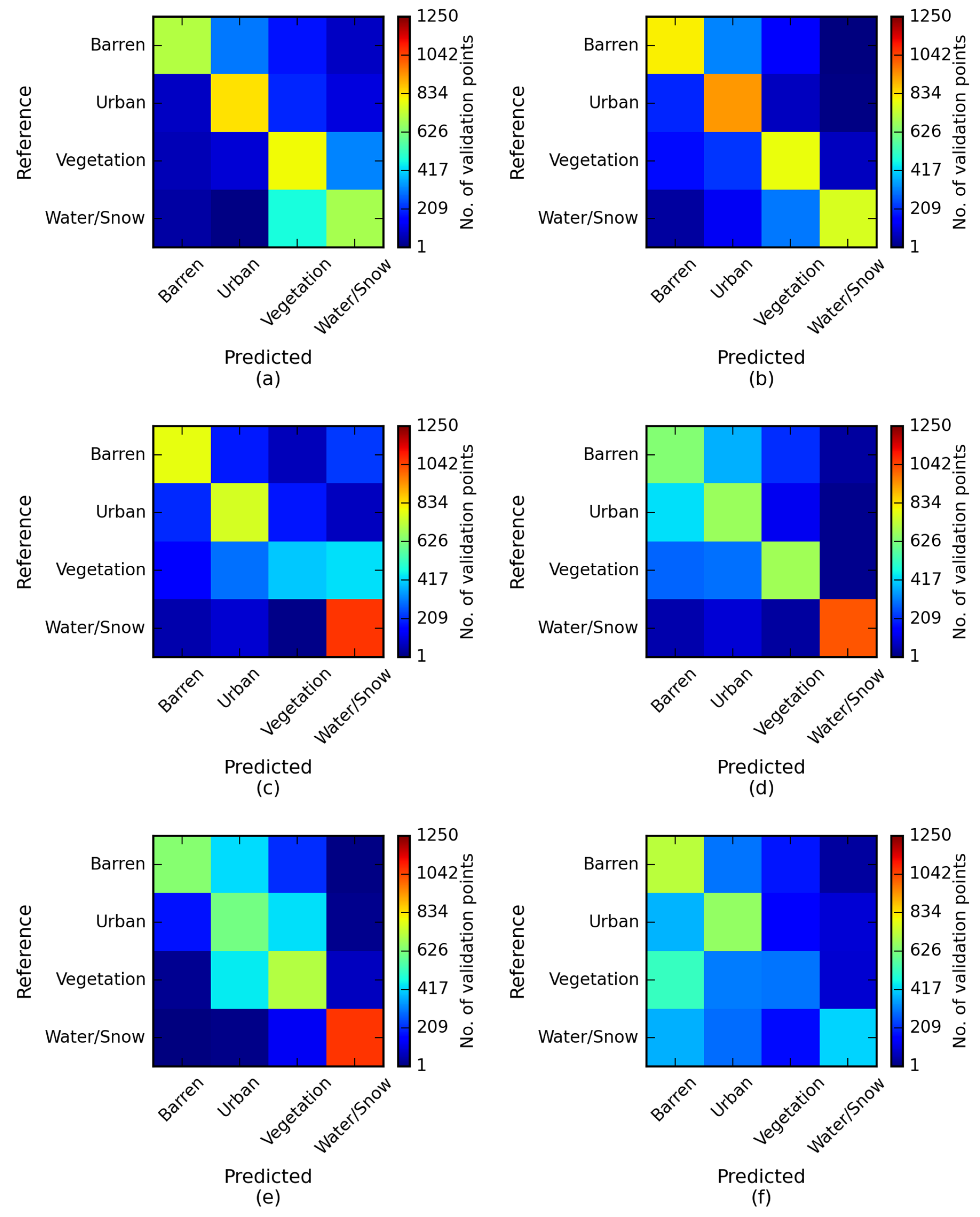A Biophysical Image Compositing Technique for the Global-Scale Extraction and Mapping of Barren Lands
Abstract
:1. Introduction
2. Methodology
2.1. Creation of Biophysical Image Composite (BIC)
2.2. Evaluation of Soil/Bareness Indexes
2.3. Global Mapping of Barren Lands
3. Results and Discussion
3.1. Performance of Soil/Bareness Indexes
3.2. The BIC and Its Performance
3.3. Global Barren Land Cover Map
4. Conclusions
Author Contributions
Conflicts of Interest
References
- UN General Assembly. Transforming Our World: The 2030 Agenda for Sustainable Development; The Global Initiative Against Transnational Organized Crime: Geneva, Switzerland, 2015. [Google Scholar]
- Prospero, J.M.; Ginoux, P.; Torres, O.; Nicholson, S.E.; Gill, T.E. Environmental characterization of global sources of atmospheric soil dust identified with the Nimbus 7 Total Ozone Mapping Spectrometer (TOMS) absorbing aerosol product. Rev. Geophys. 2002, 40, 1–2. [Google Scholar] [CrossRef]
- Engelstädter, S.; Kohfeld, K.E.; Tegen, I.; Harrison, S.P. Controls of dust emissions by vegetation and topographic depressions: An evaluation using dust storm frequency data. Geophys. Res. Lett. 2003. [Google Scholar] [CrossRef]
- Kim, D.; Chin, M.; Bian, H.; Tan, Q.; Brown, M.E.; Zheng, T.; Kucsera, T. The effect of the dynamic surface bareness on dust source function, emission, and distribution. J. Geophys. Res. Atmos. 2013, 118, 871–886. [Google Scholar] [CrossRef]
- Twomey, S.A.; Piepgrass, M.; Wolfe, T.L. An assessment of the impact of pollution on global cloud albedo. Tellus 1984. [Google Scholar] [CrossRef]
- Charlson, R.J.; Schwartz, S.E.; Hales, J.M.; Cess, R.D.; Coakley, J.A.; Hansen, J.E.; Hofmann, D.J. Climate forcing by anthropogenic aerosols. Science 1992, 255, 423–430. [Google Scholar] [CrossRef] [PubMed]
- Hansen, J.; Sato, M.; Lacis, A.; Ruedy, R. The missing climate forcing. Philos. Trans. R. Soc. Lond. B Biol. Sci. 1997, 352, 231–240. [Google Scholar] [CrossRef]
- Chin, M.; Diehl, T.; Ginoux, P.; Malm, W. Intercontinental transport of pollution and dust aerosols: Implications for regional air quality. Atmos. Chem. Phys. 2007, 7, 5501–5517. [Google Scholar] [CrossRef]
- Seaton, A.; Godden, D.; MacNee, W.; Donaldson, K. Particulate air pollution and acute health effects. Lancet 1995, 345, 176–178. [Google Scholar] [CrossRef]
- Mills, N.L.; Donaldson, K.; Hadoke, P.W.; Boon, N.A.; MacNee, W.; Cassee, F.R.; Newby, D.E. Adverse cardiovascular effects of air pollution. Nat. Clin. Pract. Cardiovasc. Med. 2009, 6, 36–44. [Google Scholar] [CrossRef] [PubMed]
- Rogers, A.S.; Kearney, M.S. Reducing signature variability in unmixing coastal marsh Thematic Mapper scenes using spectral indices. Int. J. Remote Sens. 2004, 25, 2317–2335. [Google Scholar] [CrossRef]
- Zhao, H.; Xiaoling, C. Use of normalized difference bareness index in quickly mapping bare areas from TM/ETM+. In Proceedings of the IGARSS ’05, Seoul, Korea, 25–19 July 2005.
- Li, S.; Chen, X. A new bare-soil index for rapid mapping developing areas using LANDSAT 8 data. Int. Arch. Photogramm. Remote Sens. Spat. Inf. Sci. 2014, 40, 139–145. [Google Scholar] [CrossRef]
- Deng, Y.; Wu, C.; Li, M.; Chen, R. RNDSI: A ratio normalized difference soil index for remote sensing of urban/suburban environments. Int. J. Appl. Earth Obs. Geoinf. 2015, 39, 40–48. [Google Scholar] [CrossRef]
- Friedl, M.A.; Sulla-Menashe, D.; Tan, B.; Schneider, A.; Ramankutty, N.; Sibley, A.; Huang, X. MODIS Collection 5 global land cover: Algorithm refinements and characterization of new datasets. Remote Sens. Environ. 2010, 114, 168–182. [Google Scholar] [CrossRef]
- Tateishi, R.; Hoan, N.T.; Kobayashi, T.; Alsaaideh, B.; Tana, G.; Phong, D.X. Production of global land cover data–GLCNMO2008. J. Geogr. Geol. 2014, 6, 99–123. [Google Scholar] [CrossRef]
- Arino, O.; Ramos-Perez, J.J.; Kalogirou, V.; Bontemps, S.; Defourny, P.; Van Bogaert, E. Global land cover map for 2009 (GlobCover 2009). PANGAEA 2009. [Google Scholar] [CrossRef]
- Schaaf, C.B.; Gao, F.; Strahler, A.H.; Lucht, W.; Li, X.; Tsang, T.; Roy, D. First operational BRDF, albedo nadir reflectance products from MODIS. Remote Sens. Environ. 2002, 83, 135–148. [Google Scholar] [CrossRef]
- Rouse, J., Jr.; Haas, R.; Schell, J.; Deering, D. Monitoring Vegetation Systems in the Great Plains with ERTS; NASA: Washington, DC, USA, 1974.
- Tucker, C.J. Red and photographic infrared linear combinations for monitoring vegetation. Remote Sens. Environ. 1979, 8, 127–150. [Google Scholar] [CrossRef]
- MODTBGA MODIS/Terra Thermal Bands Daily L2G-Lite Global 1km SIN Grid V006. Available online: http://doi.org/10.5067/MODIS/MODTBGA.006 (accessed on 29 November 2016).
- Breiman, L.; Friedman, J.H.; Olshen, R.A.; Stone, C.J. Classification and Regression Trees; Wadsworth: Belmont, CA, USA, 1984. [Google Scholar]
- Breiman, L. Random forests. Mach. Learn. 2001, 45, 5–32. [Google Scholar] [CrossRef]
- Sharma, R.C.; Tateishi, R.; Hara, K.; Gharechelou, S.; Iizuka, K. Global mapping of urban built-up areas of year 2014 by combining MODIS multispectral data with VIIRS nighttime light data. Int. J. Digit. Earth 2016, 23, 1–17. [Google Scholar] [CrossRef]
- Cohen, J. A Coefficient of agreement for nominal scales. Educ. Psychol. Meas. 1960, 20, 37–46. [Google Scholar] [CrossRef]








| Indexes | Overall Accuracy | Kappa Coefficient |
|---|---|---|
| NDSI (Min) | 0.62 | 0.49 |
| NDSI (Max) | 0.65 | 0.54 |
| NDSI2 (Min) | 0.60 | 0.47 |
| NDSI2 (Max) | 0.61 | 0.48 |
| NDBI (Min) | 0.62 | 0.49 |
| NDBI (Max) | 0.41 | 0.22 |
| BIC | 0.86 | 0.80 |
| Maps | Overall Accuracy | Kappa Coefficient |
|---|---|---|
| MCD12Q1 2013 | 0.87 | 0.61 |
| Our map 2013 | 0.92 | 0.83 |
© 2016 by the authors; licensee MDPI, Basel, Switzerland. This article is an open access article distributed under the terms and conditions of the Creative Commons Attribution (CC-BY) license (http://creativecommons.org/licenses/by/4.0/).
Share and Cite
Sharma, R.C.; Tateishi, R.; Hara, K. A Biophysical Image Compositing Technique for the Global-Scale Extraction and Mapping of Barren Lands. ISPRS Int. J. Geo-Inf. 2016, 5, 225. https://doi.org/10.3390/ijgi5120225
Sharma RC, Tateishi R, Hara K. A Biophysical Image Compositing Technique for the Global-Scale Extraction and Mapping of Barren Lands. ISPRS International Journal of Geo-Information. 2016; 5(12):225. https://doi.org/10.3390/ijgi5120225
Chicago/Turabian StyleSharma, Ram C., Ryutaro Tateishi, and Keitarou Hara. 2016. "A Biophysical Image Compositing Technique for the Global-Scale Extraction and Mapping of Barren Lands" ISPRS International Journal of Geo-Information 5, no. 12: 225. https://doi.org/10.3390/ijgi5120225





